Readers of this blog are undoubtedly aware of the recent reports of the destruction of the Monastery of Mar Behnam and Sara (see here, here, and elsewhere). The fate of the monastery’s manuscripts is now unknown. Not long ago, at least, HMML and the CNMO (Centre numérique des manuscrits orientaux) digitized the collection. A short-form catalog of these 500+ manuscripts has been prepared for HMML by Joshua Falconer, and I have taken a more detailed look at a select number of manuscripts in the collection. From this latter group I would like to highlight a few and share them with you. The texts mentioned below are biblical, hagiographic, apocryphal/parabiblical, historical, poetic, theological, medical, lexicographic, and grammatical. Here I merely give a few rough notes, nothing comprehensive, along with some images, but in any case the value and variety of these endangered manuscripts will, I hope, be obvious.
These manuscripts, together with those of the whole collection, are available for viewing and study through HMML (details for access online and otherwise here).
MBM 1
Syriac Pentateuch. Pages of old endpapers in Syriac, Garšūnī, and Arabic. Very many marginal comments deserving of further study to see how they fit within Syriac exegetical tradition. The comments are anchored to specific words in the text by signs such as +, x, ~, ÷. According to the original foliation, the first 31 folios are missing.
- Gen 1r-58v (beg miss; starts at 20:10)
- Ex 59r-129v
- Lev 129v-180v
- Num 181r-241r
- Deut 241r-283v (end miss; ends at 28:44)

MBM 1, f. 105v, with marginal note to Ex 28:37, with the Greek letter form of the tetragrammaton.
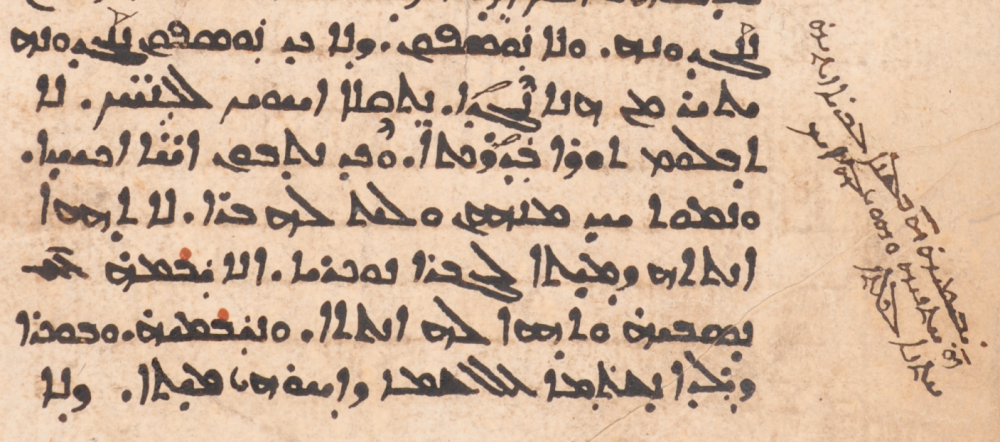
MBM 1, f. 275v, with marginal note on Dt 25:5 explaining ybm as a Hebrew word.
MBM 20
Syriac texts on Mary and the young Jesus. Folio(s) missing, and the remaining text is somewhat disheveled. In addition, some pages are worn or otherwise damaged. Colophon on 79v, but incomplete.
- The Book of the Upbringing of Jesus, i.e. the Syriac Infancy Gospel, 1r-12v. Beg. miss. See the published text of Wright, Contributions to the Apocryphal Literature of the New Testament, pp. 11-16 (Syr), available here.
- The Six Books Dormition 13r-79r (beg and end miss?). See Wright, “The Departure of my Lady from this World,” Journal of Sacred Literature and Biblical Record 6 (1865): 417–48; 7: 110–60. (See also his Contributions to the Apocryphal Literature) and Agnes Smith Lewis, Apocrypha Syriaca, pp. 22-115 (Syr), 12-69 (ET); Arabic version, with LT,by Maximilian Enger, Ioannis Apostoli de transitu beatae Mariae Virginis liber (Elberfeld, 1854) available here. In this copy, the end of the second book is marked at 24v, and that of the fifth book on 30v. As indicated above, there are apparently some missing folios and disarranged text.
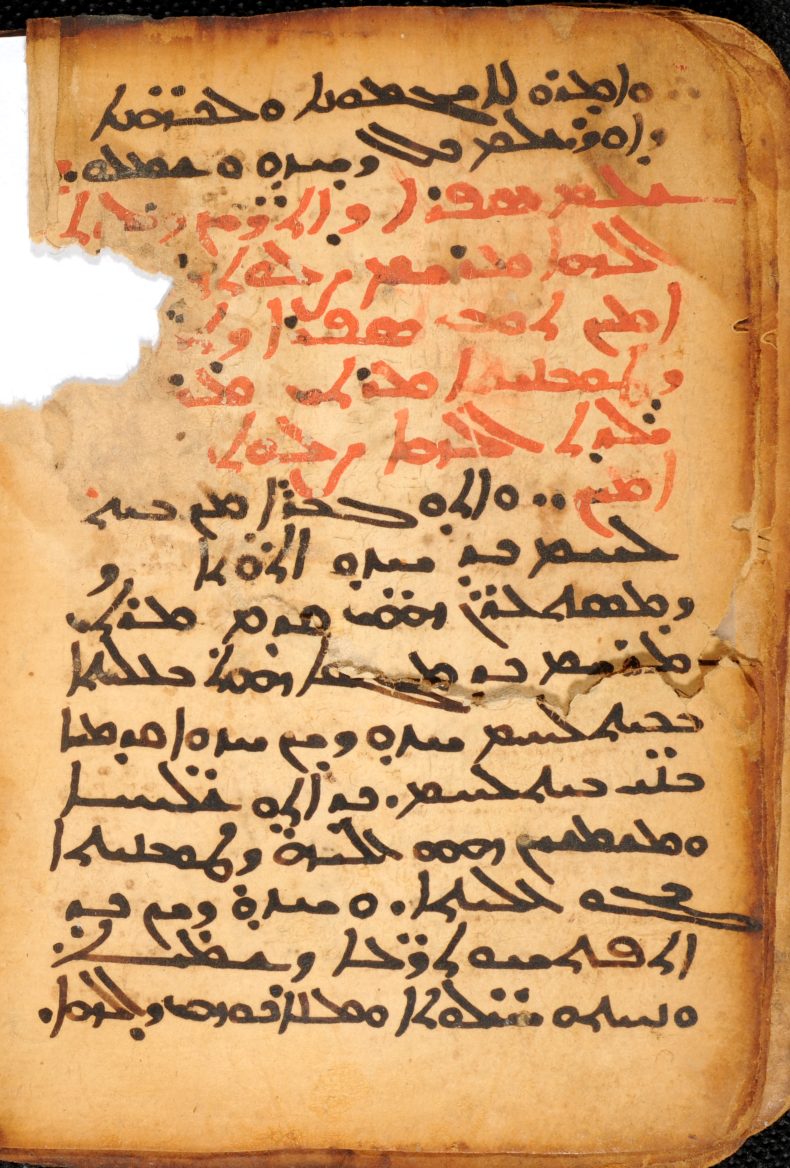
MBM 20, f. 24v. End of bk 2, start of bk 3 of the Six Books.
MBM 120
Another copy of Eliya of Nisibis, Book of the Translator, on which see my article in JSS 58 (2013): 297-322 (available here).
MBM 141
Bar ʿEbrāyā’s Metrical Grammar. Colophon on 99r: copied in the monastery of Symeon the Stylite, Nisan (April) 22, at the ninth hour in the evening of Mar Gewargis in the year 1901 AG = 1590 CE.
MBM 144
Bar ʿEbrāyā’s Metrical Grammar, d. 1492/3 on 78v. Clear script, but not very pretty.
MBM 146
Bar ʿEbrāyā, Book of Rays. Lots of marginalia in Syriac, Arabic, and Garšūnī.
MBM 152
Bar Bahlul’s Lexicon, 18th cent. Beg. miss. Some folios numbered by original scribe in the outer margin with Syriac letters, often decorated. Nice writing. Beautiful marbled endpapers, impressed Syriac title on spine.

MBM 152, spine.
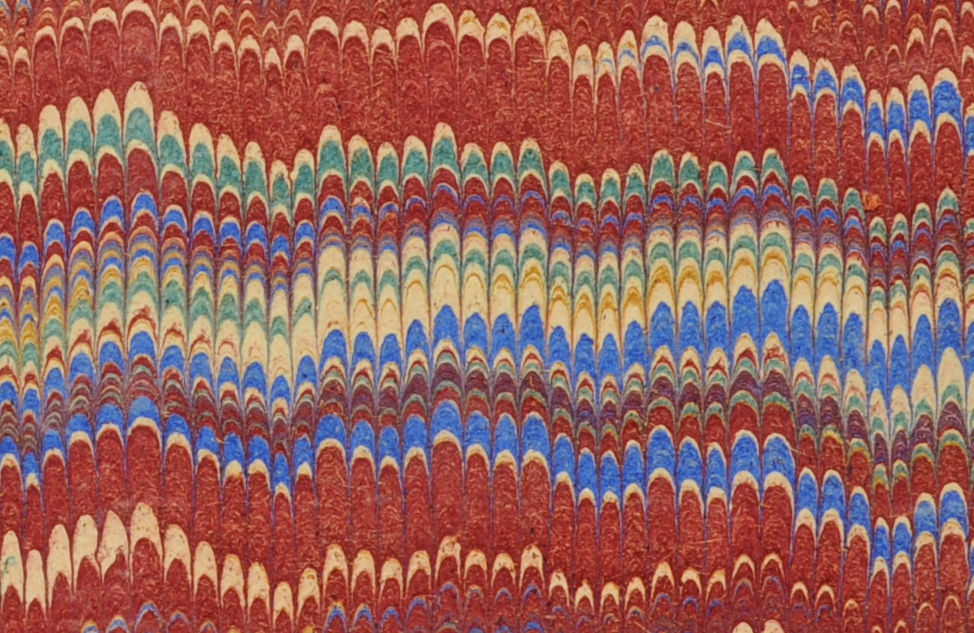
MBM 152, marbled endpapers.
MBM 172
The Six Books Dormition, Garšūnī, from books 5-6, 16th cent. (?).
MBM 207
Hagiography, &c., Garšūnī, 16th/17th cent. According to the original foliation, the first eleven folios are missing from the manuscript.
- 1r end of the Protoevangelium Jacobi (for the corresponding Syriac part, cf. pp. 21-22 in Smith Lewis’s ed. here). Here called “The Second Book, the Birth”.
- 1r-31v Vision of Theophilus, here called “The Third Book, on the Flight to Egypt…” Cf. GCAL I 229-232; Syriac and Arabic in M. Guidi, in Rendiconti della Accademia dei Lincei, Classe di scienze morali, storiche e filologiche, 26 (1917): 381-469 (here); Syriac, with ET, here.
- 31v-37v book 6, The Funeral Service (taǧnīz) of Mary
- 37v-39r Another ending, from another copy, of this book 6
- 39r-62r Miracle of Mary in the City of Euphemia
- 62r-72v Marina and Eugenius
- 72v-96r Behnam & Sara (new scribe at ff 83-84)
- 96r-104r Mart Shmoni and sons
- 104r-112v Euphemia (another scribe 112-114)
- 112v-124v Archellides
- 124v-131r Alexis, Man of God, son of Euphemianus
- 131v-141v John of the Golden Gospel
- 141v-147v Eugenia, Daughter of the King/Emperor (incom)
MBM 209
19th cent., Garšūnī, hagiography. Not very pretty writing, but includes some notable texts (not a complete list): Job the Righteous 3v, Jonah 14v, Story of the Three Friends 24r (?), Joseph 73r, Ahiqar 154v, Solomon 180v, and at the end, another Sindbad text 197v-end (see the previous posts here and here).
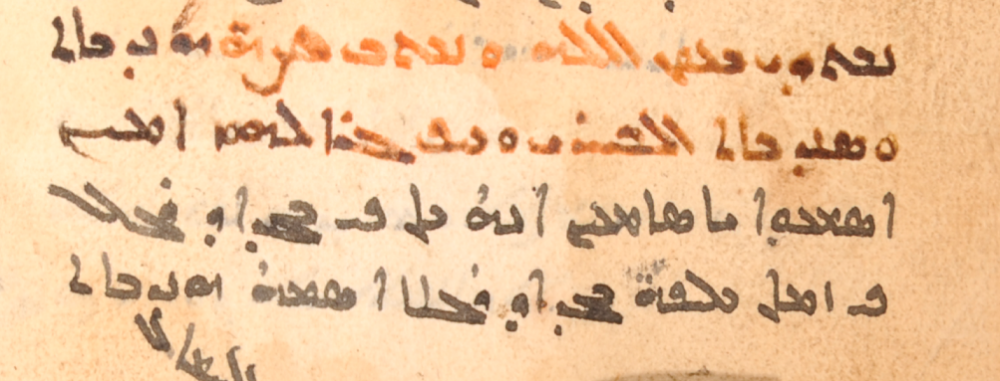
MBM 209, f. 197v. The Story of Hindbād and Sindbād the Sailor.
MBM 250
Medical, very nice ES Garšūnī. Includes Ḥunayn’s Arabic translation of the Summary of Galen’s On the Kinds of Urine (fī aṣnāf al-bawl), ff. 1v-8r; cf. here. For a longer Greek text, see Kuehn, Claudii Galeni Opera Omnia (Leipzig, 1821-33), vol. 19, pp. 574-601. These now separate folios seem originally to have been the eighth quire of another codex.
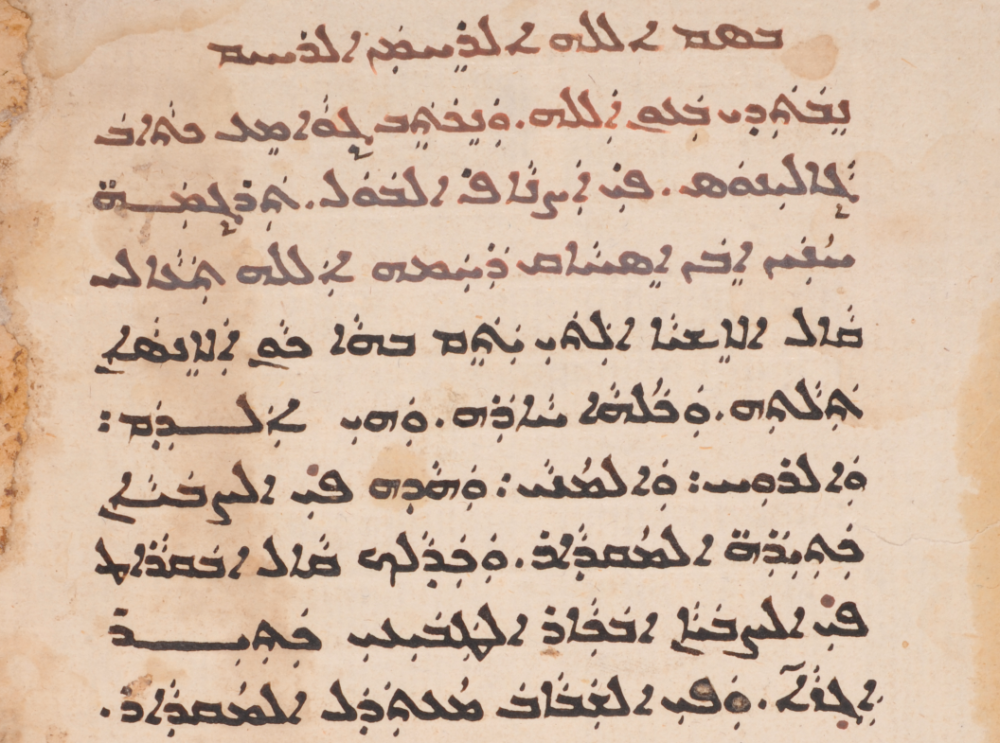
MBM 250, f. 1v. Beg. of Ḥunayn’s Arabic translation of the Summary of Galen’s On the Kinds of Urine.
MBM 270
John of Damascus, De fide Orthodoxa, Arabic (cf. Graf, GCAL II, p. 57, this ms not listed). Fine writing. 16th/17th cent.

MBM 270, f. 5v. John of Damascus, Arabic.
MBM 342
A late copy (19th cent.), but with a fine hand, of the Kitāb fiqh al-luġa, by Abū Manṣūr ʿAbd al-Malik b. Muḥammad al-Ṯaʿālibī, a classified dictionary: e.g. § 17 animals (82), § 23 clothing (155), § 24 food (173), § 28 plants (205), § 29 Arabic and Persian (207, fīmā yaǧrá maǧrá al-muwāzana bayna al-ʿarabīya wa-‘l-fārisīya).
MBM 364
Syriac, 15th cent. (?). F. 10v has quire marker for end of № 11. The manuscript has several notes in different hands:
- 29v, a note with the year 1542 (AG? = 1230/1 CE); Ascension and Easter are mentioned
- 31v, note: “I had a spiritual brother named Ṣlibā MDYYʾ. He gave me this book.” (cf. 90v)
- 66v, note: “Whoever reads this book, let him pray for Gerwargis and ʿIšoʿ, the insignificant monks.”
- 90v, note: Ownership-note and prayer-request for, it seems, the monk Ṣlibonā (cf. 31v)
- 132v, longish note similar to the note on 168v
- 157r, note: “Theodore. Please pray, for the Lord’s sake.”
- 168v, note: “I found this spiritual book among the books of the church of the Theotokos that is in Beth Kudida [see PS 1691], and I did not know [whether] it belonged to the church or not.”
For at least some of the contents, cf. the Syriac Palladius, as indicated below.
- Mamllā of Mark the Solitary, Admonition on the Spiritual Law 1r-17r
Second memra 17r
Third memra 41v
Fourth memra 48r
- Letters of Ammonius 67r-78v (see here; cf. with Kmosko in PO 10 and further CPG 2380)
- “From the Teaching of Evagrius” 78v-100r
- Confession of Evagrius 100v
- Abraham of Nathpar 101r-117v
2nd memra 105r
3rd memra 109v
4th memra 110v
5th memra 115v
- Teachings of Abba Macarius 117v
- Letter (apparently of Macarius) 130r-130v
- Letter of Basil to Gregory his Brother 131r-139v
- Letter from a solitary to the brothers 139v-142r
- Sayings of Evagrius 142r-146v
- Gluttony 147v
- The Vice of Whoring (ʿal ḥaššā d-zānyutā) 147v
- Greed 148r
- Anger 149r
- Grief 149v
- On the Interruption of Thought (ʿal quṭṭāʿ reʿyānā) 149v
- Pride 150r
- From the Tradition (mašlmānutā) of Evagrius 151r
- On the Blessed Capiton (here spelled qypyṭn) 151r (cf. Budge, Book of Paradise, vol. 2, Syr. text, p. 223)
- The Blessed Eustathius 151v
- Mark the Mourner 151v
- A student of a great elder in Scetis 152r
- A student of another elder who sat alone in his cell 155v
- A student of a desert elder 156r
- (more short saint texts) 157v-161r
- Tahsia 161r-164r (cf. Budge, Book of Paradise, vol. 2, Syr. text, p. 173)
- An Elder named Zakarya 164r
- Gregory 168r
- Daniel of Ṣalaḥ 180v
- Philemon 180v (cf. Budge, Book of Paradise, vol. 2, Syr. text, p. 427)
- One of the Blessed Brothers 181r
- Pachomius, with various subtexts and miracles 182v
- Didymus 188v-190v
MBM 365
Arabic, 15th century (?). Second, but probably contemporaneous with the first, scribe begins at 80r.
- 1r-34r Pss 38:17-150 (end)
- 34r-79v maqāla 11 by Saint Simʿān, maqāla 12 by Simʿān, … maqāla 16 by Simʿān on 67r. There is some apparent disarray and missing folios: the end of this group of texts seems really to be 78v, but 79r has “Sayings and Questions of Abū ‘l-qiddīs Simʿān”
- 80r-114r Jn 7:20-21:25 (i.e. end of the Gospel)

MBM 365, f. 79r, the beginning of the Saying and Questions of Saint Simʿān
MBM 367
Two loose folios of an Arabic tafsīr of the Gospels, one of which has the quire marker for the original thirty-first quire (so numbered with Syriac letters). Perhaps 16th cent. From Mt 10, with commentary (qāla ‘l-mufassir), on 1v (image below); Lk 6:20 ff. on f. 2r.

MBM 367, f. 1v. Mt 10:19-23 with the beginning of the commentary.
MBM 368
Garšūnī (very nice, clear script). Memre and other texts on theological, monastic, and spiritual subjects.
MBM 386
17th cent., Garšūnī, hagiography. Note the Qartmin trilogy beginning on 105v.
- The Book of the Ten Viziers / Arabic version of the Persian Baḫtīār Nāma 1r (beg miss). (On this work, see W.L. Hanaway, Jr., in EIr here.) It is a frame story spread over several days with a boy (ġulām) telling smaller stories (sg. ḥadīṯ) to a king. As it now stands in the manuscript, it begins in the eighth day, ending on the eleventh. (ET of the Persian here by William Ouseley; ET by John Payne of an Arabic version with Alf layla wa-layla here, eighth day beg. on p. 125). Here are the subdivisions:
The Story of [the city of] Īlān Šāh and Abū Tamām 1v
Ninth day 7r
King Ibrāhīm and his son (on 9r, marginalia in Arabic: “this is an impossible thing!”)
Tenth day 14r
Story of Sulaymān 15v
Eleventh day, 29v
- Infancy Gospel of Jesus 33v-55r
- John of Dailam 55r-68v
- Behnām and Sara 68v-73v
- Mar Zakkay 73v-105r (at 105r it says Mar Malke)
- Mar Gabriel 105v-132r (much of f. 111 torn away; partly f. 127, too)
- Mar Samuel 132v- (folios miss. after ff. 141, 157)
- Mar Symeon -163v (begins where?)
- Memra of Ephrem on Andrew when he entered the land of the dogs 163v
- Miracle of Mary 170v
- Miracle of Mark of Jabal Tarmaq 172v
MBM 388
17th cent., ES Garšūnī, mostly hagiography. Colophon on 135v.
- Story of Susanna
- Ephrem on Elijah 14r
- Story of a Jewish Boy and what happened to him with some Christian children 31v (hands change at 34r)
- Story of some royal children 40v (some Syriac, hands change at 47r)
- Story of Tatos the martyr (f.), martyred in Rome 51r
- Story of a Mistreated Monk 58v
- Story of Arsānīs, King of Egypt 66v
- John of the Golden Gospel 70v (folio(s) missing after 70v)
- Elijah the Zealous 88v
- Andrew the Apostle 100v
- Text by Eliya Catholicos, Patriarch 111r
- Zosimus and the Story of the Rechabites 116r
- Story of the Apple 131r (several other copies at HMML: CFMM 350, pp. 717-722; CFMM 109, ff. 179v-182r; CFMM 110, 182v-185v; ZFRN 73, pp. 382-390 and more)
MBM 390
17th cent., WS Garšūnī, some folios missing, hagiographic, homiletic, &c.
- Ahiqar 1r (on 27r dated 2006 AG in Arabic script)
- Merchant of Tagrit and his Believing Wife 27v
- Chrysostom, On Receiving the Divine Mysteries 34r
- Chrysostom, On Repentance and Receiving the Divine Mysteries 44v (s.t. miss. after 51v)
- Ephrem, (beg. miss.) 52r ? (s.t. miss. after 67v)
- Jacob of Serug, On Repentance 69v (s.t. miss after 69v)
- Ephrem ? 94r
- From the Fathers, That everyone has a guardian angel 102v (hands change just b/f this)
- Story of Petra of Africa 110r (no other Arabic/Garšūnī at HMML; for Syriac, see CFMM 270, pp. 291-302)
- Zosimus and the Story of the Rechabites, 119v-132r
- Life of John the Baptist 132r
- Five Miracles of John the Baptist 150r
- Story of Macarius (end miss) 152v-153v
MBM 469
Ecclesiasticus, Garšūnī, with some Turkish-Arabic/Garsh equivalents at beginning.

MBM 469, f. 1v. Turkish words with Arabic/Garšūnī equivalents.
Here are the forms on this page, first in Turkish, then Arabic:
- ıslattı naqaʿa [he soaked]
- aramış fattaša [he searched]
- aradın fattašta [you searched]
- aradım fattaštu [I searched]
- aramışlar fattašū [they searched]
- işitti samiʿa [he heard]
- içti šariba [he drank] *The Turkish root here is written with š for ç, as in Kazakh; on the previous page the verb also appears and is spelled ʾyǧty, i.e. içti (Garšūnī ǧīm = Turkish c or ç.)
Note that for the forms of aramak [to search], the third person forms are past indefinite, while the first and second person forms are past definite.
MBM 485
From a Gospel lectionary, Syriac, Estrangela. Here is f. 6v, with Mt 18:15-17, 20:1-3.
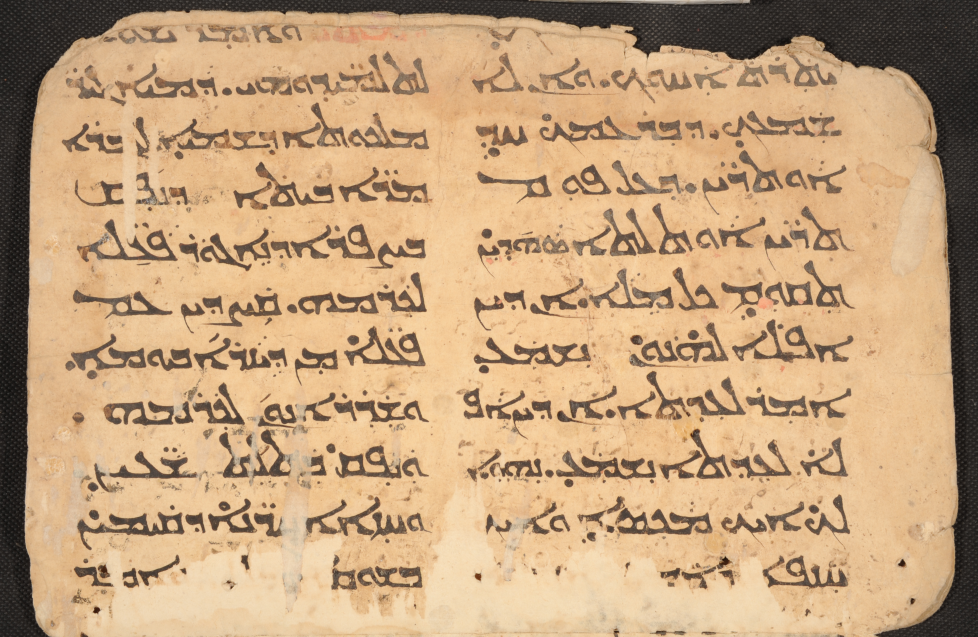
MBM 485, f. 6v. Mt 18:15-17, 20:1-3.
MBM 489
French drama translated into Syriac by Abraham ʿIso in Baghdad, 1972-1974.
- [5r] title page
- [6r-7v] introduction
- pp. 5-122 Athalie by Racine
- pp. 125-244 Le Cid by Corneille
- pp. 247-380 Polyeucte by Corneille
- pp. 381-463 Esther by Racine

MBM 489, f. 74r = p. 125. Title page to the Syriac translation of Corneille’s Le Cid.
With the first page of the Syriac Le Cid cf. the original text here. Note that the Syriac translation is in rhyming couplets like the French.

MBM 489, f. 77r = p. 131. The beginning of the Syriac Le Cid.
MBM 509
19th cent., Arabic. ʿAbd al-Laṭīf al-Baġdādī. Starts with excerpt from Ibn Abī Uṣaybiʿa on him (cf. the end of the ms). On 14r begins the K. al-Ifāda wa-‘l-iʿtibār fī ‘l-umūr wa-‘l-mušāhada wa-‘l-ḥawādiṯ al-muʿāyana bi-arḍ Miṣr. See De Sacy’s annotated FT here.
Here is the part from ch. 4, on monuments (beg. 30r), about the burning of the library of Alexandria by ʿAmr b. al-ʿĀṣ “with the permission of ʿUmar” and on the Pharos of Alex (bottom of 34v = de Sacy p. 183).

MBM 509, f. 34v.
MBM 514
Printed work. Mariano Ugolini. Vasco de Gama al Cabo das Tormentas, dodecasillabi siriaci con versione italiana. Rome, Tipografia Poliglotta, 1898. “Poesia letta in Roma nella solenne accademia per le feste centenarie della scoperta delle Indie, il giorno 21 Maggio 1898.” 6 pages. Bound with Rahmani’s Testamentum Domini.
Here are the first six lines:

MBM 514, p. 4.
And the same in Italian:

MBM 514, p. 5.
Readers of this blog are undoubtedly aware of the recent reports of the destruction of the Monastery of Mar Behnam and Sara (see here, here, and elsewhere). The fate of the monastery’s manuscripts is now unknown. Not long ago, at least, HMML and the CNMO (Centre numérique des manuscrits orientaux) digitized the collection. A short-form catalog of these 500+ manuscripts has been prepared for HMML by Joshua Falconer, and I have taken a more detailed look at a select number of manuscripts in the collection. From this latter group I would like to highlight a few and share them with you. The texts mentioned below are biblical, hagiographic, apocryphal/parabiblical, historical, poetic, theological, medical, lexicographic, and grammatical. Here I merely give a few rough notes, nothing comprehensive, along with some images, but in any case the value and variety of these endangered manuscripts will, I hope, be obvious.
These manuscripts, together with those of the whole collection, are available for viewing and study through HMML (details for access online and otherwise here).
MBM 1
Syriac Pentateuch. Pages of old endpapers in Syriac, Garšūnī, and Arabic. Very many marginal comments deserving of further study to see how they fit within Syriac exegetical tradition. The comments are anchored to specific words in the text by signs such as +, x, ~, ÷. According to the original foliation, the first 31 folios are missing.
MBM 1, f. 105v, with marginal note to Ex 28:37, with the Greek letter form of the tetragrammaton.
MBM 1, f. 275v, with marginal note on Dt 25:5 explaining ybm as a Hebrew word.
MBM 20
Syriac texts on Mary and the young Jesus. Folio(s) missing, and the remaining text is somewhat disheveled. In addition, some pages are worn or otherwise damaged. Colophon on 79v, but incomplete.
MBM 20, f. 24v. End of bk 2, start of bk 3 of the Six Books.
MBM 120
Another copy of Eliya of Nisibis, Book of the Translator, on which see my article in JSS 58 (2013): 297-322 (available here).
MBM 141
Bar ʿEbrāyā’s Metrical Grammar. Colophon on 99r: copied in the monastery of Symeon the Stylite, Nisan (April) 22, at the ninth hour in the evening of Mar Gewargis in the year 1901 AG = 1590 CE.
MBM 144
Bar ʿEbrāyā’s Metrical Grammar, d. 1492/3 on 78v. Clear script, but not very pretty.
MBM 146
Bar ʿEbrāyā, Book of Rays. Lots of marginalia in Syriac, Arabic, and Garšūnī.
MBM 152
Bar Bahlul’s Lexicon, 18th cent. Beg. miss. Some folios numbered by original scribe in the outer margin with Syriac letters, often decorated. Nice writing. Beautiful marbled endpapers, impressed Syriac title on spine.
MBM 152, spine.
MBM 152, marbled endpapers.
MBM 172
The Six Books Dormition, Garšūnī, from books 5-6, 16th cent. (?).
MBM 207
Hagiography, &c., Garšūnī, 16th/17th cent. According to the original foliation, the first eleven folios are missing from the manuscript.
MBM 209
19th cent., Garšūnī, hagiography. Not very pretty writing, but includes some notable texts (not a complete list): Job the Righteous 3v, Jonah 14v, Story of the Three Friends 24r (?), Joseph 73r, Ahiqar 154v, Solomon 180v, and at the end, another Sindbad text 197v-end (see the previous posts here and here).
MBM 209, f. 197v. The Story of Hindbād and Sindbād the Sailor.
MBM 250
Medical, very nice ES Garšūnī. Includes Ḥunayn’s Arabic translation of the Summary of Galen’s On the Kinds of Urine (fī aṣnāf al-bawl), ff. 1v-8r; cf. here. For a longer Greek text, see Kuehn, Claudii Galeni Opera Omnia (Leipzig, 1821-33), vol. 19, pp. 574-601. These now separate folios seem originally to have been the eighth quire of another codex.
MBM 250, f. 1v. Beg. of Ḥunayn’s Arabic translation of the Summary of Galen’s On the Kinds of Urine.
MBM 270
John of Damascus, De fide Orthodoxa, Arabic (cf. Graf, GCAL II, p. 57, this ms not listed). Fine writing. 16th/17th cent.
MBM 270, f. 5v. John of Damascus, Arabic.
MBM 342
A late copy (19th cent.), but with a fine hand, of the Kitāb fiqh al-luġa, by Abū Manṣūr ʿAbd al-Malik b. Muḥammad al-Ṯaʿālibī, a classified dictionary: e.g. § 17 animals (82), § 23 clothing (155), § 24 food (173), § 28 plants (205), § 29 Arabic and Persian (207, fīmā yaǧrá maǧrá al-muwāzana bayna al-ʿarabīya wa-‘l-fārisīya).
MBM 364
Syriac, 15th cent. (?). F. 10v has quire marker for end of № 11. The manuscript has several notes in different hands:
For at least some of the contents, cf. the Syriac Palladius, as indicated below.
Second memra 17r
Third memra 41v
Fourth memra 48r
2nd memra 105r
3rd memra 109v
4th memra 110v
5th memra 115v
MBM 365
Arabic, 15th century (?). Second, but probably contemporaneous with the first, scribe begins at 80r.
MBM 365, f. 79r, the beginning of the Saying and Questions of Saint Simʿān
MBM 367
Two loose folios of an Arabic tafsīr of the Gospels, one of which has the quire marker for the original thirty-first quire (so numbered with Syriac letters). Perhaps 16th cent. From Mt 10, with commentary (qāla ‘l-mufassir), on 1v (image below); Lk 6:20 ff. on f. 2r.
MBM 367, f. 1v. Mt 10:19-23 with the beginning of the commentary.
MBM 368
Garšūnī (very nice, clear script). Memre and other texts on theological, monastic, and spiritual subjects.
MBM 386
17th cent., Garšūnī, hagiography. Note the Qartmin trilogy beginning on 105v.
The Story of [the city of] Īlān Šāh and Abū Tamām 1v
Ninth day 7r
King Ibrāhīm and his son (on 9r, marginalia in Arabic: “this is an impossible thing!”)
Tenth day 14r
Story of Sulaymān 15v
Eleventh day, 29v
MBM 388
17th cent., ES Garšūnī, mostly hagiography. Colophon on 135v.
MBM 390
17th cent., WS Garšūnī, some folios missing, hagiographic, homiletic, &c.
MBM 469
Ecclesiasticus, Garšūnī, with some Turkish-Arabic/Garsh equivalents at beginning.
MBM 469, f. 1v. Turkish words with Arabic/Garšūnī equivalents.
Here are the forms on this page, first in Turkish, then Arabic:
Note that for the forms of aramak [to search], the third person forms are past indefinite, while the first and second person forms are past definite.
MBM 485
From a Gospel lectionary, Syriac, Estrangela. Here is f. 6v, with Mt 18:15-17, 20:1-3.
MBM 485, f. 6v. Mt 18:15-17, 20:1-3.
MBM 489
French drama translated into Syriac by Abraham ʿIso in Baghdad, 1972-1974.
MBM 489, f. 74r = p. 125. Title page to the Syriac translation of Corneille’s Le Cid.
With the first page of the Syriac Le Cid cf. the original text here. Note that the Syriac translation is in rhyming couplets like the French.
MBM 489, f. 77r = p. 131. The beginning of the Syriac Le Cid.
MBM 509
19th cent., Arabic. ʿAbd al-Laṭīf al-Baġdādī. Starts with excerpt from Ibn Abī Uṣaybiʿa on him (cf. the end of the ms). On 14r begins the K. al-Ifāda wa-‘l-iʿtibār fī ‘l-umūr wa-‘l-mušāhada wa-‘l-ḥawādiṯ al-muʿāyana bi-arḍ Miṣr. See De Sacy’s annotated FT here.
Here is the part from ch. 4, on monuments (beg. 30r), about the burning of the library of Alexandria by ʿAmr b. al-ʿĀṣ “with the permission of ʿUmar” and on the Pharos of Alex (bottom of 34v = de Sacy p. 183).
MBM 509, f. 34v.
MBM 514
Printed work. Mariano Ugolini. Vasco de Gama al Cabo das Tormentas, dodecasillabi siriaci con versione italiana. Rome, Tipografia Poliglotta, 1898. “Poesia letta in Roma nella solenne accademia per le feste centenarie della scoperta delle Indie, il giorno 21 Maggio 1898.” 6 pages. Bound with Rahmani’s Testamentum Domini.
Here are the first six lines:
MBM 514, p. 4.
And the same in Italian:
MBM 514, p. 5.
Share this:
Related